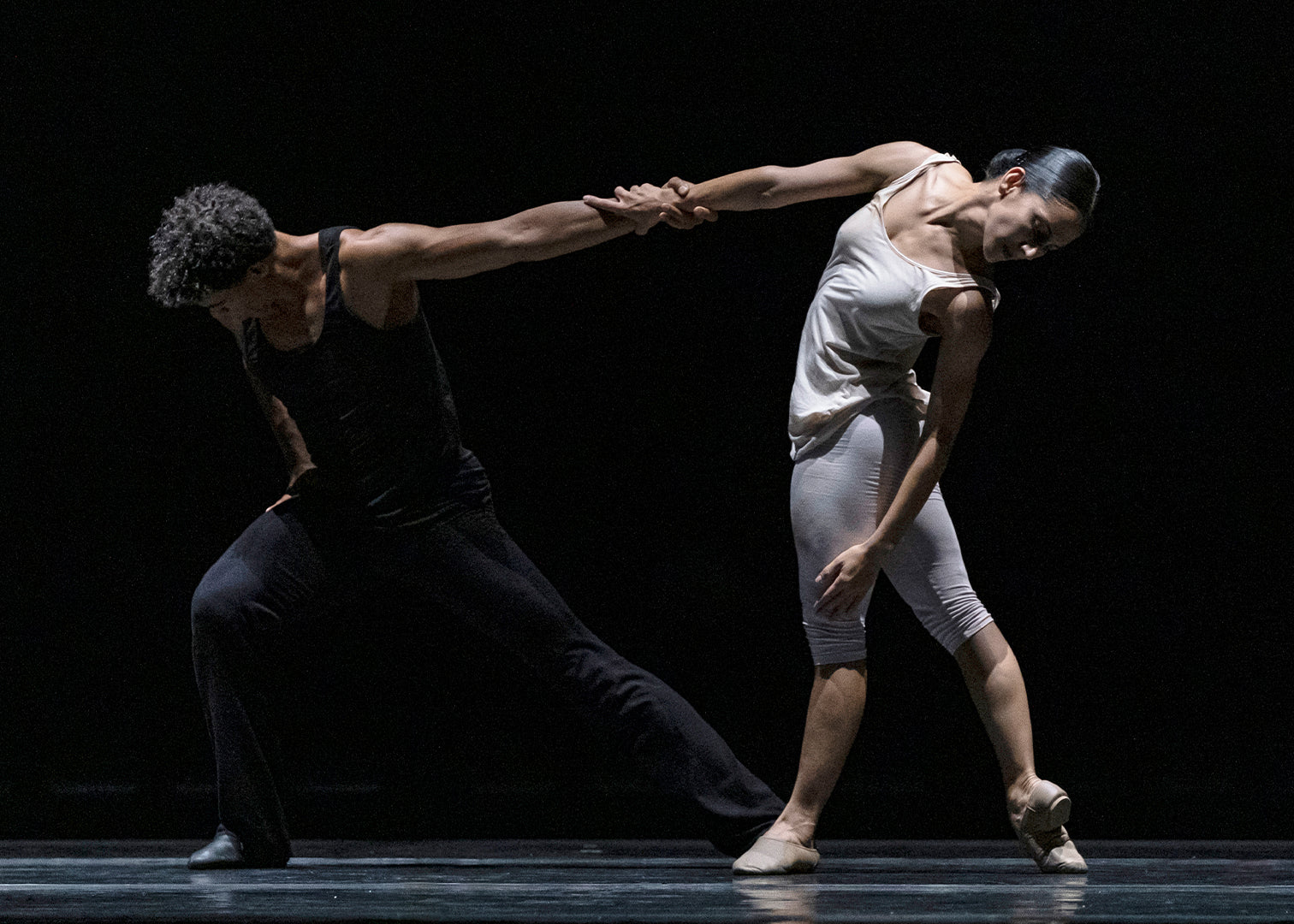Thirteen songs as “a ‘funeral playlist’ . . . describing particular emotional states and the insistence of time.”[note]Stephanie Lake, Choreographer’s Note, “Skeleton Tree” program, Malthouse Theatre, Melbourne, Victoria, 2019, 3[/note] Just as Lake cautions that the thirteen “vivid portraits” do not follow a thread of narrative or consequence, the portraits depict more than one experience of death and loss from more than one point of view. The performers, James O’Hara, Nicola Leahey, and Marlo Benjamin are the body that passes, and the mourners that live on; they are the departed and those left behind.
And at times, their pulsating movements even read like separate yet interconnected organs within the human body as it begins to shut down. As the pulse increases and the body temperature swings from hot to cold, they skitter. They throb as a red rash above the heart and across the back of the kidneys as blood gathers to answer the alarm call of the major organs. Dance movements like failing organs: this look at death is bodily.
This
look at death is frank: death is certain. This look at death is affirmative,
unsentimental, and clear-eyed.
It begins with a curtain call, with “Final Bow” in the dying light, accompanied by the recorded sounds of an audiences’ applause. O’Hara, Leahey, and Benjamin bow as if at the end of a performance; in their death, to lean upon T.S. Eliot, the beginning.[note]T.S. Eliot, “In my beginning is my end” from “East Coker,” Four Quartets, The Poetry Foundation, accessed March 24, 2019 [/note] A nod perhaps to the cyclic inevitability of where I will soon end up, clapping at the end of a performance, spent, having travelled so far in the course of one night. Upon their faces, I also read something of the exhaustion and vulnerability of performance.
Joan Baez melts what mountain stood with “Babe I’m Gonna Leave You,” (to accompany the second meditation, “Melting Mountain”) and Melbourne grindcore band, Agents of Abhorrence, obliterate what is left with “Thousand Year Seesaw” (fifth meditation, “The Whirling”), but it is the “Ritual” (sixth meditation) of Robin Fox’s “Gin Soaked Bones” that constricts the airway at my throat. The human condition, laid bare. So simple. So raw and tender. The sound of rain falling upon metal grows louder. Not rain falling upon a roof, for the surface area sounds smaller than that. But rain falling upon what I picture to be a small lid of metal. The size of an outstretched body. I picture a metal canopy over the performers as they cleanse the body for its next journey. It shields them, but extends no further as a structure. It is possibly a lid to a tomb or a door closing on one world and reopening on another. Encouraged to “watch the work through the lens of [my own] own mortality,”[note]Stephane Lake, “Skeleton Tree” program, Malthouse Theatre, 3[/note] I see an afterlife. As O’Hara and Benjamin prepare the body of Leahey, in quiet ceremony, an outstretched hand upon the body’s final departure reads as a farewell looping back to Baez: “You know I’d really like to stay here;” I love you; don’t forget me. Gradually, we move to the sea.
“Hyper Alive” (eleventh meditation) is what remains of those left behind. Life goes on, brutally so, in the sped-up movements of O’Hara, Leahey, and Benjamin. They apply a lick of deodorant to their armpits, they release an unheard but imagined guttural roar, they repeat their everyday actions. Life goes on, without you, whether you want it to or not: “I am living. I remember you.”[note]Marie Howe, “What the living do,” Poets.org, accessed March 24, 2019 [/note]
I find release and acceptance within the ache and sadness of “Long Sleep,” to Nick Cave’s “Distant Sky” lament with Danish singer Else Torp. The delicate line, “let us go now, my only companion,” pervades every minute movement of O’Hara and every non-movement of Leahey, as he rolls her now-lifeless form across the empty stage. The weight of the body is heavy once the spirit no longer moves it, and conversely, the weight is light, a lifeless shell that housed what was. The firm and delicate geography of the human condition.
As the sun rises in our eyes,[note]Let us go now, my darling companion
Set out for the distant skies
See the sun, see it rising
See it rising, rising in your eyes
Nick Cave, “Distant Sky,” 2018[/note] a shimmering swan appears. Leahey is a gold-leaf Dying Swan of both the original poem of Lord Alfred Tennyson, and the body and spirit poem of Anna Pavlova. A hopeful line of contemporary verse! From which also springs a couplet by Philip Larkin, from his small tale to tell the whole: “Of each other, we should be kind. While there is still time.”[note]The mower stalled, twice; kneeling, I found
A hedgehog jammed
up against the blades,
Killed. It had
been in the long grass.
I had seen it
before, and even fed it, once.
Now I had mauled
its unobtrusive world
Unmendably. Burial
was no help:
Next morning I got
up and it did not.
The first day
after a death, the new absence
Is always the
same; we should be careful
Of each other, we
should be kind
While there is
still time.
Philip Larkin, “The Mower,” from Collected Poems, The Poetry Foundation, accessed March 24, 2019 [/note]









comments